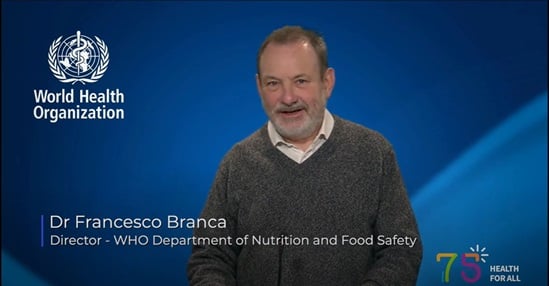Child growth
Child malnutrition is a major public health issue worldwide. An estimated 144 million children under age 5 are stunted, 47 million are wasted and 38.3 million have overweight or obesity. Around 45% of deaths among children under 5 years of age are linked to undernutrition.
Measuring the growth of infants and children is an important part of child health surveillance. Inadequate infant growth due to poor nutrition leads to under-nutrition in children in many low- and middle-income countries, which, if followed later in life by an increased intake of calories, can result in overweight or obesity.
The WHO Child Growth Standards are a diagnostic tool used to monitor and assess the nutritional status of infants and young children worldwide. By tracking children’s height and body weight, the standards detect children or populations not growing properly, or who are underweight or at risk of overweight, and who may require specific health services or public health responses.
The WHO Child Growth Standards have charts for boys and girls separated, covering age birth to 5 years. They are used in doctors’ offices, clinics and other health facilities, and by research institutions, child health advocacy organizations and ministries of health
Child stunting refers to a child who is too short for his or her age and is the result of chronic or recurrent malnutrition. Stunting is a contributing risk factor to child mortality and is also a marker of inequalities in human development. Child overweight refers to a child who is too heavy for his or her height. This form of malnutrition usually results from expending too few calories for the amount of food consumed or from endocrine disbalances, and it increases the risk of noncommunicable diseases later in life. Child wasting refers to a child who is too thin for his or her height and is the result of recent rapid weight loss or the failure to gain weight. A child who is moderately or severely wasted has an increased risk of death, but treatment is possible.
Childhood wasting and overweight are both forms of malnutrition and can coexist in a population. In 2020, wasting (low weight for height) and overweight was found in 6.7% of children under 5 (45.4 million) and 5.7% of children under 5 (38.9 million), respectively.
In 2020, 22% of children under age 5 worldwide (149.2 million) suffered from stunting, a decline from 24.4% in 2015. To achieve the target of a 50% reduction in the number of stunted children by 2030, the annual rate of decline must double (to 3.9% per year) from its current annual reduction rate of 2.1% per year.
Although malnutrition can manifest in multiple ways, the path to prevention is virtually identical: adequate maternal nutrition before and during pregnancy and while breastfeeding; optimal breastfeeding in the first two years of life; nutritious, diverse and safe complementary foods in early childhood; and a healthy environment, including access to basic health, water, hygiene and sanitation services and opportunities for safe physical activity.
Many of these vital pathways to good nutrition are under threat – including due to the COVID-19 pandemic – and have the potential to undermine progress towards ending malnutrition in all its forms. As the world responds to and recovers from the pandemic, urgent action is critical to protect maternal and child nutrition – especially in the most affected regions – and secure a future where the right to nutrition is a reality for every child.









